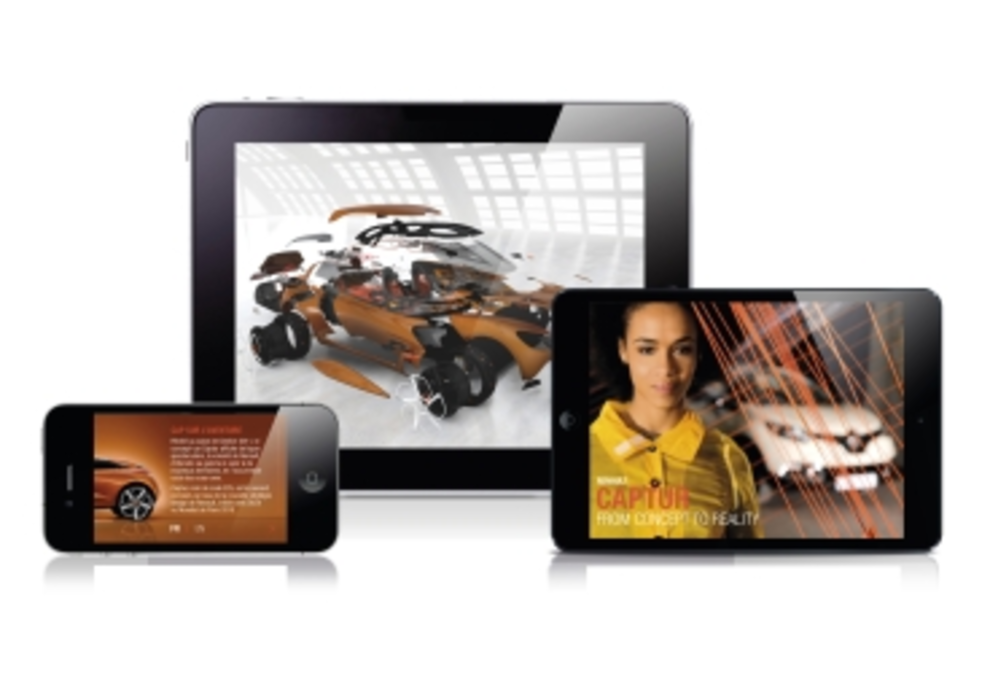The Back Story: In an ideal world, all app experiences would be engrossing, engaging, meaningful, interactive, and highly relevant—and Renault aims to inhabit that world. Today, mobile sits firmly in the driver seat at the French car company.
“Mobile allows for two things that desktop cannot fulfill,” says Philippe Reynaud, head of mobile devices at Renault. “On the one hand, it offers a complete immersive experience [and] on the other hand it offers personalized and geo-localized services that, while they can be provided by desktop browsers, in reality are more frequently consulted on mobile.”
But several years ago the brand didn’t have much of a mobile strategy in place at all, says Reynaud—yet its customers were clamoring for mobility. “We noticed many people were trying to access our desktop site through a mobile device,” he says. “So we anticipated customer need with our own vision of how mobile could revolutionize car industry marketing.”
The Solution: That’s also why mobile was very much top-of-mind in the lead-up to the March 2013 launch of the Captur, Renault’s mini-crossover SUV. To help design an e-book app for iPad that would drive engagement and appeal to current and potential Renault customers, the brand called on the services of Adobe France and the Adobe Digital Publishing Suite (DPS).
The Captur app mixes education and play to teach consumers about the car’s various features in action through video, slideshows, animation, a 3D visualizer, and other interactive elements. Users can turn the car’s virtual headlights on and off; zoom in to view the interior; or break the car into its constituent parts and dive deep into its layers, almost like with the organs in a med school skeleton. In another part of the app, users can scroll through images illustrating the process through which the Captur went from concept car to reality. There’s also the option to play music throughout the in-app experience—a noteworthy feature considering many apps are either strangely silent or don’t allow a continuous piece of music to play while users toggle through pages. A funny “making of” video at the end rounds out the experience.
“Apps that are successful employ the smart use of interactivity to articulate the band story,” says Dave Dickson, senior product marketing manager at Adobe. “Rather than merely using interactivity as ‘bells and whistles’ to attract the consumer into the app, the Renault app allows consumers to…familiarize themselves with the product through an interactive experience, and hopefully become one step closer to purchase.”
The app also fit nicely into Renault’s overall digital “Capture the Day” launch campaign that included TV and social media to encourage fans to seek out the magical moments in their daily lives—like sunrises and fun with friends—and share photos on Instagram tagged #capturetheday.
“What was interesting with the app was how it amplified all that sharing and connected everything we were doing together,” says Boris Petrovitch Njegosh, Renault’s corporate identity designer. “It’s social, it’s a website, it’s mobile all together—and that gave it more efficiency and made it into more of an experience.”
The Digital Publishing Suite allowed Renault to roll out the app in record time, says Njegosh, whose wife actually had a baby in the midst of app development—though he says, jokingly, that didn’t stop him from being able to easily approve and work on assets in the DPS cloud while in the nursery. The Captur app project kicked off on January 28, 2013—and the app was in stores and ready to be downloaded less than two months later on March 5.
Njegosh says he also appreciated how the platform allowed him and his team to repurpose content.
“DPS illustrates very well the concept of ‘create once, publish everywhere,” he says. “What you build with DPS for a mobile app can be easily reused to make rich media banners, desktop HTML5 pages, and social media material.”
The Results: Within two months after launch, the Captur app had roughly 10,000 downloads and stood at fourth place in the e-book section of the app store. Twenty-five percent of users spent between 10 and 60 minutes on the app, and the share ratio was more than 4%.
Njegosh attributes its success to good storytelling and a smooth interface.
“For us, mobile—and more precisely apps—are a direct path to bring our customers closer to the Renault brand,” he says. “The resonance between the car and the app design allows users to immediately realize they’re engaging in a premium experience; it’s a basic example of the holistic design strategy we’re planning to push to all our forthcoming experiences.”
The Takeaway: The future is mobile and the future is here, says Adobe’s Dickson.
“The paradigm on how consumers communicate has clearly shifted over even the last two to three years—mobile devices are proliferating and a compelling part of how consumers communicate with each other, and how they form their perceptions of and interact with brands,” Dickson says. “ Brands that don’t ‘think mobile’—in terms of company organization, budgeting, and marketing strategy—risk missing out on this immense opportunity to drive revenue and consumer engagement.”






